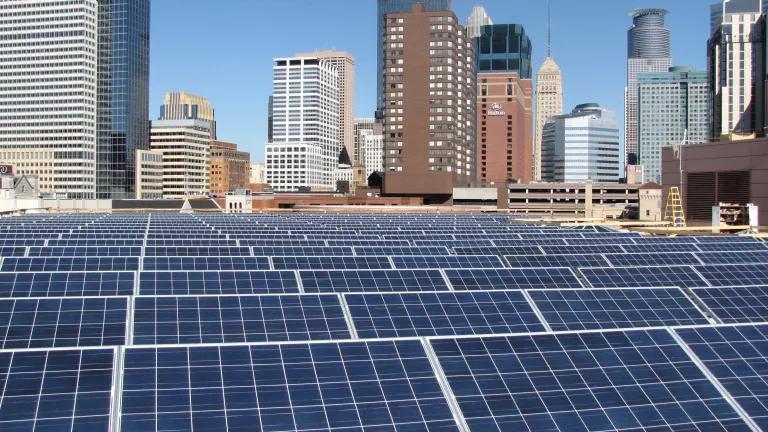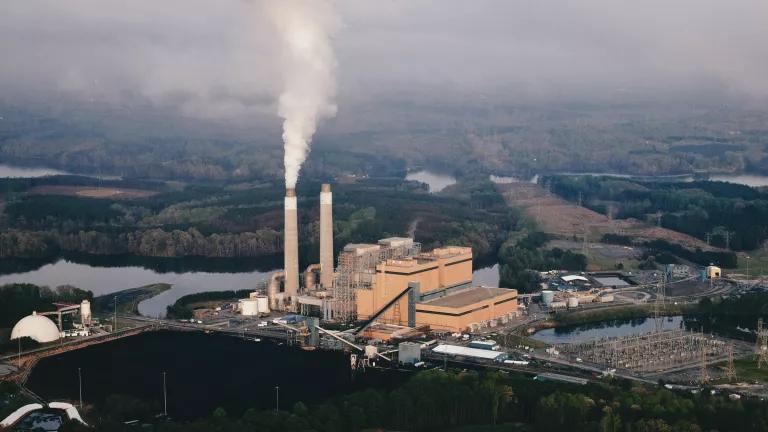EPA’s Good Neighbor Plan Will Cut Smog, Save Lives
The Good Neighbor Plan is the latest version of EPA’s federal plan to clean up air pollution that travels from one state to another, as required by the Clean Air Act.

Environmental and public health advocates submitted more than 72,000 public comments to EPA on the proposed Good Neighbor Plan at an event on June 21, 2022.
The Good Neighbor Plan (GNP) is the latest version of the U.S. Environmental Protection Agency’s (EPA) federal plan to clean up air pollution that travels from one state to another, as required by the Clean Air Act (CAA). It is an expansion of its predecessor, the Cross-State Air Pollution Rule (CSAPR) because pollution cuts are always necessary where deaths and illnesses are preventable.
This new plan works by requiring deeper air pollution cuts from fossil fuel–burning power plants and expanding control obligations to pollution-generating industrial sources with the greatest potential for impact. EPA projects that the safeguards will yield up to $250 billion in health-related benefits over the next 20 years. EPA also forecasts that when controls expand to industrial sources in 2026, the new rule will prevent as many as 1.3 million cases of asthma symptoms and 470,000 school absence days, in that year alone.
The GNP directly addresses ozone and particulate matter (specifically, the smallest size of regulated particles, PM 2.5, that are 2.5 microns and smaller), which are pollutants that cause premature death and respiratory illness. In the short-term, ozone exposure causes respiratory effects, likely causes metabolic effects, and possibly central nervous system effects, cardiovascular effects, and mortality. Fine particles cause premature mortality, regardless of chemical composition, and both short-term and long-term (more than 1 month) exposures to PM 2.5 cause cardiovascular problems and mortality. Long-term PM 2.5 exposure is likely to cause cancer and nervous system effects; it is also suggestive of reproductive and metabolic problems.
Ozone is particularly potent from May through the end of September, referred to as the ozone season. By reducing ozone season and annual ozone-forming nitrogen oxide (NOx) emissions, the GNP would generate many benefits. Less NOx means less human exposure to ozone, resulting in fewer ozone-related health effects. The plan will also reduce direct PM 2.5 and indirect PM 2.5 by reducing their precursors NOx and sulfur dioxide (SO2).
Wind carries these air pollutants from pollution-generating sources in upwind states to other parts of the country. There are two categories of sources addressed by the GNP: electric generating units (EGUs) and nonelectric generating units (non-EGUs). EGUs refer to power plants and have been covered by previous versions of the rule. Non-EGUs are industrial (manufacturers of cement, iron, steel, glass, etc.) plants. As demonstrated by the map below, the GNP targets 26 upwind states whose air pollution from EGUs and non-EGUs is carried to downwind states, worsening air pollution levels there.

Upwind States Contributing Above 1% to Downwind States in 2023 for the 2015 Ozone NAAQS
The Clean Air Act gives EPA the necessary policy tools to create solutions for these health and safety problems. It requires EPA to set national health standards for air quality (National Ambient Air Quality Standards, or NAAQS) every five years. The most recent NAAQS for ozone was strengthened in 2015, when the prior 75 parts per billion (ppb) standard was lowered to 70 ppb. Even then, however, EPA’s outside science advisors, the Clean Air Scientific Advisory Committee, advised the EPA administrator “to set the level of the standard lower than 70 ppb within a range down to 60 ppb, taking into account your judgment regarding the desired margin of safety to protect public health.” EPA is currently reconsidering the Trump EPA’s refusal to strengthen the ozone health standard in the face of compelling evidence that 70 ppb remains unsafe.
Areas that have air pollution concentrations below the NAAQS are called attainment areas. Areas whose concentrations exceed the NAAQS are called non-attainment areas and signal that human health is at particular risk. The GNP is the EPA’s plan to help downwind states achieve and maintain attainment and improve human health in those areas.
The CAA also requires that states create implementation plans (SIPs) that include a strategy to reach attainment. The good neighbor provision in the act requires SIPs from states that contribute at least 1 percent to nonattainment of the NAAQS, or that have problems maintaining compliance with the NAAQS in one or more other states. EPA must issue a federal implementation plan (FIP) if a state has not submitted an SIP, or if the SIP is insufficient. The previous EPA FIP that served this role was the 2011 CSPAR, which addressed the 2008 ozone standard of 75 ppb. These transboundary rules were then updated in 2016 and 2021, continuing to address the outdated and unsafe 2008 ozone standard of 75 ppb.
The GNP is not only the first version of EPA interstate air pollution rules to address the new 70 ppb ozone standard but it is also the first version to extend emission reductions to non-EGUs. Comparing the tables below shows that, as a result of the proposed plan, benefits from avoided short- and long-term ozone and PM 2.5 effects increase from 2023 to 2026, when non-EGU controls are phased in.


Additional benefits come from the GNP's controls on industrial sources starting in 2026
The GNP targets ozone and PM 2.5 concentrations by way of cutting NOx emissions, which form ozone when they react with sunlight. The GNP creates NOx emissions budgets for power plants and NOx emissions standards for industrial plants during the ozone season, to address ozone- and particulate matter–related health and safety problems. This strategy is projected to reduce NOx emissions from the power sector in 25 covered states by 29 percent and cut NOx emissions from the industrial sector by 15 percent in 23 covered states, affecting 26 states in total.
Technology called Selective Catalytic Reduction (SCR) and Selective Non-Catalytic Reduction (SNCR) control NOx emissions from EGUs and many non-EGUs. NOx emissions also may be lowered with other less-effective combustion controls, and generation shifting from higher- to lower-emitting units, e.g., from coal-burning units to those that burn methane gas. This approach is rooted in the expectation that controls will be operated effectively and consistently.
The control strategies for EGUs affect 25 upwind states and will be phased in starting in the 2023 ozone season. The phased-in budgets are first set at what is immediately achievable with currently installed technology. In 2024, a daily emissions rate limit takes effect for large coal-burning power plants with existing controls, then in 2027, the rate limit will take effect for those installing new controls. Starting in 2025, budgets adjust to account for new power plant retirements and units, as well as changing operation.
In 2026, the EPA budgets are set at levels that can be achieved through the installation and operation of SCR controls placed on about 30 percent of large coal-burning power plants. This is the same year the EPA determined controls could be installed at non-EGU’s in 23 upwind states. The agency identified seven industries where upwind NOx emissions reductions would meaningfully impact air quality in the affected downwind states. EPA is proposing NOx standards for glass, iron, and steel furnaces; cement kilns; iron and steel boilers; high-emitting manufacturing of pulp, paper, paperboard, petroleum, and coal products; basic chemical manufacturing boilers; and internal combustion engines. The EPA determined that 2026 is the earliest date when controls could be installed across those industries.
The combination of EGUs and non-EGUs in the phase-in strategy will cut 94,000 tons per year of ozone-forming NOx emissions in the 2026 ozone season. Half will come from EGUs reducing their ozone season emissions and the other half from non-EGUs. The GNP would bring an additional reduction of SO2 by 106,000 tons, fine particle emissions by 9,000 tons, and CO2 by 40 million metric tons in 2026.
Mortality risk reductions account for the majority of the proposed rule’s projected $250 billion in benefits—more than 95 percent of monetized ozone-related benefits and more than 98 percent of PM 2.5–related benefits. EPA expects some emissions controls to be operated year-round at EGUs and seeks comments for the year-round operation of controls at non-EGUs. EPA provides estimates of health benefits in its proposal for year-round control operation at EGUs, for public awareness, but does not factor them into the total benefits of the proposal. If control measures are operated year-round, there could be even greater benefits.
The benefits of this proposed plan exceed the costs by substantial, impressive margins. The net annual benefits of the GNP are $15 billion each year, from 2023 to 2042. The proposed GNP’s vast unquantifiable benefits include improved visibility in national and state parks and protection of ecosystems, coastal waters and estuaries, and forests.
The GNP targets ozone and NOx that wind transports over long distances, across state lines, harming Americans and communities in downwind states that lack any regulatory or political influence over the upwind polluters and their home states. Importantly, the GNP will save lives, improve public health and air quality, and will do so cost-effectively.




